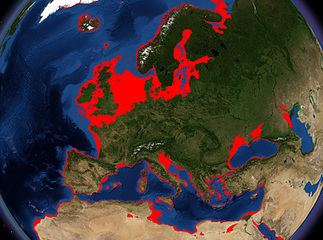For most of human history on this planet—about 90 per cent of the time—sea levels have been substantially lower than at present, exposing large tracts of territory for human settlement. Europe alone would have had a land area increased by 40 per cent at the maximum sea level regression (Figure 1). Although this has been recognised for many decades, archaeologists have resisted embracing its full implications, barely accepting that most evidence of Palaeolithic marine exploitation must by definition be invisible, believing that nothing has survived or can be found on the seabed, and preferring instead to emphasise the opportunities afforded by lower sea level for improved terrestrial dispersal across land bridges and narrowed sea channels.
In the past decade, opinions have begun to change in response to a number of factors: evidence that marine exploitation and seafaring have a much deeper history in the Pleistocene than previously recognised; the steady accumulation of new underwater Stone Age sites and materials, amounting now to over 3000 in Europe, and often with unusual and spectacular conditions of preservation; availability of new technologies and research strategies for underwater exploration; and the growth of targeted underwater research (Erlandson 2001; Bailey & Milner 2002; Anderson et al. 2010; Benjamin et al. 2011).
Read the full article on antiquity.ac.uk
Via Past Horizons
jueves, 29 de noviembre de 2012
Suscribirse a:
Enviar comentarios (Atom)








No hay comentarios:
Publicar un comentario